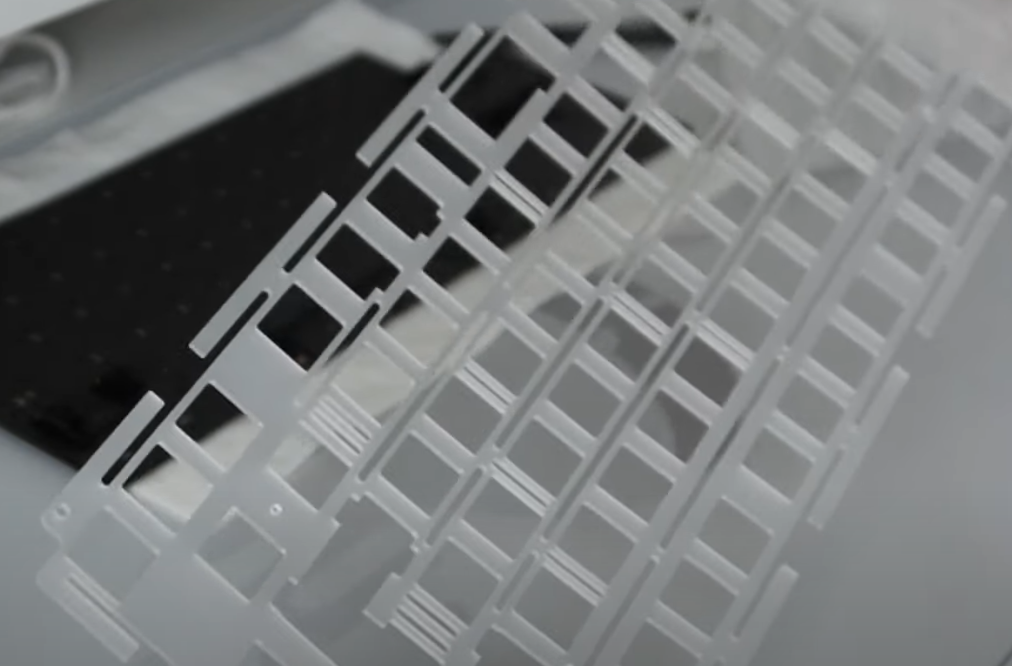When building a custom mechanical keyboard, one of the most exciting yet often confusing choices you’ll make is selecting the plate material. The primary purpose of the plate is to keep your switches aligned and provide a sturdier typing experience. There are also certain boards that allow for a plateless build, which make for a bouncier and less restricted feel. Having a plate can significantly impact not only the sound of each keystroke but the feel of your typing as well. Different materials offer unique characters, allowing you to customize the typing experience to suit your personal preferences. In this blog post, we’ll dive into several popular plate materials available and explore how each one can shape the final feel and acoustics of your keyboard build.
1. PC (Polycarbonate)
PC plates are one of the more popular choices amongst the community. They are favored by those who prefer a softer, more flexible typing experience and they tend to produce a lower, more muted sound compared to metal plates. They are often translucent as well, which makes them visually appealing in RGB builds.

2. Aluminum
Aluminum plates are widely valued for their sturdiness and crisp typing feel. They offer much less flex than PC or other plastic-based plates, which in turn translates to a firmer typing feel and a bright, sharp sound profile. This acoustic is preferred by many enthusiasts for its clarity and crispness, particularly with tactile and clicky switches.

3. FR4
FR4 plates are gaining popularity in the community for their balanced feel and unique characteristics. It is a composite material made from woven fiberflass closs with an epoxy resin binder, commonly used in PCBs. This material provides a balance of rigidity and flexibility that falls somewhere between polycarbonate and aluminum, making it a versatile option. They offer moderate flexibility, softer than aluminum but stiffer than polycarbonate. They are known for producing a relatively muted, thocky sound and is a good halfway point that combines qualities of both plastic-based and metal plates.

4. POM (Polyoxymethylene)
POM plates are my personal favorite material to use out of all the options. They are a relatively flexible plastic like polycarbonate but offer a more cushioned typing experience, often described as soft. This particular feel makes it extremely pleasant to type on and I love the gentle key impact. They can produce a distinctive, creamy sound and they work particularly well with linear switches as their surface is completely smooth. I highly recommend POM plates to those who seek a creamier, thocky build and a soft, quiet typing experience.

5. Brass
Brass is a dense, heavy metal making them among the most rigid options available. Typists who enjoy a highly stable, sturdy typing experience with strong feedback will find brass plates ideal. They are famous for their pingy sound profile but overall produce a more warm, rounded clack. They add a substantial weight to many keyboard builds which contributes to an overall premium feel (and price :P). The material also naturally oxidizes over time, developing a unique patina that many users find visually appealing.

6. Carbon fiber
Carbon fiber plates have a unique blend of rigidity and flexibility, leaning more toward the flexible side compared to metals like aluminum and brass. This flexibility results in a bouncy typing feel, providing a soft yet supportive keystroke. They offer a mid-range, somewhat muted sound that can be considered thocky yet crisp. Carbon fiber is extremely lightweight, which makes it a geat choice if you want to minimize the weight of your keyboard without sacrificing durability. Similar to FR4, carbon fiber offers a great middle ground between rigid metals and softer plastics.

6. Steel
Steel plates are known for their extreme rigidity, even more so than brass, providing a solid, uncompromising typing feel with virtually no flex. They produce an even sharper, crisper tone as the material amplifies the high-pitched frequencies in each keystroke and are heavier than brass.

Below, I put together my personal picks for plate materials that I’ve come to love after building a number of keyboards. Keep in mind that I generally prefer deeper, thockier pitched builds so the plate materials I choose are always plastic-based!
- POM: If it’s available as an option, I will almost always choose this!
- PC: If POM is not available then this is my default :P
- FR4: If I feel like going with something a bit different hehe.
In summary, you can refer to this simple graphic I put together to gauge the overall sound and feel of each keyboard material; hopefully this helps some of you narrow down your options when the time comes for you to pick one for a build.



Share:
The Best Switches for a Thocky Keyboard
2025 Black Friday Sale Announcement (Stackable Deals!)